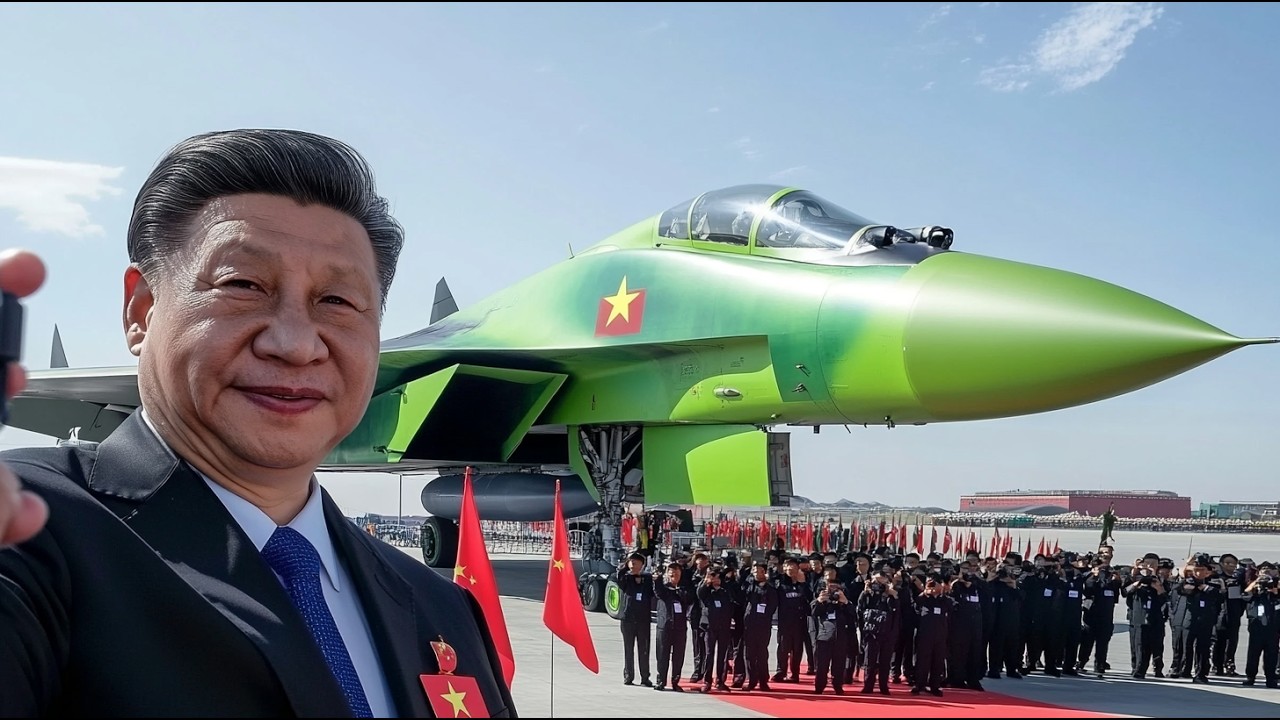China’s Hypersonic Fighter Jet: A Leap Toward Mach 16 and Beyond
In a bold stride toward redefining aviation, China has unveiled a series of hypersonic aircraft prototypes, including a fighter jet dubbed the “Nchang Number One,” which some reports claim could push the boundaries of speed to unprecedented levels. While sensational claims of reaching “the speed of light” have surfaced, the reality is no less groundbreaking: Chinese scientists and engineers are developing hypersonic vehicles capable of speeds up to Mach 16—approximately 12,300 miles per hour. This advancement, if fully realized, could transform military strategy, global travel, and the balance of power in aerospace. Here’s an in-depth look at China’s hypersonic ambitions, the technology driving them, and the challenges and opportunities they present.

The Hypersonic Frontier: What’s at Stake?
Hypersonic flight, defined as speeds exceeding Mach 5 (five times the speed of sound), represents the next frontier in aerospace. Unlike supersonic aircraft like the Concorde, which cruised at Mach 2, hypersonic vehicles operate in an extreme environment where air friction generates intense heat, and traditional propulsion systems falter. China’s pursuit of hypersonic technology is not new, but recent developments, including the 2021 test of a bulky prototype reaching Mach 6.56 and ongoing work on the Nanqiang No. 1, signal a significant leap forward. These efforts are part of a broader strategy to dominate hypersonic technology, with applications ranging from military dominance to commercial air travel.
The “Nchang Number One” fighter jet, revealed in early 2025, is a centerpiece of China’s hypersonic program. Unlike traditional fighter jets, which rely on stealth and maneuverability, this hypersonic jet prioritizes blistering speed, potentially rendering conventional air defenses obsolete. At Mach 16, the jet could theoretically travel from Beijing to New York in under an hour, a journey that currently takes over 13 hours on commercial flights. Such speeds would not only give China a strategic military advantage but also position it as a leader in ultra-fast global transportation.
The Technology Behind the Hype
At the heart of China’s hypersonic fighter jet is an innovative propulsion system: the oblique detonation engine (ODE). Unlike traditional scramjet engines, which struggle at speeds above Mach 10, the ODE uses shockwaves to enhance combustion, achieving rates up to 1,000 times faster than conventional systems. Tests conducted at the JF-12 shock tunnel in Beijing, one of the world’s most advanced hypersonic testing facilities, have demonstrated the ODE’s ability to operate between Mach 6 and Mach 16 using common kerosene-based jet fuel. This fuel choice is significant, as it reduces costs compared to specialized propellants, making the technology more scalable for both military and civilian applications.
The jet’s design also departs from the sleek, slender profiles of earlier hypersonic vehicles. Chinese engineers have opted for a bulkier airframe, addressing a critical challenge: internal space. Most hypersonic vehicles, like missiles or unmanned drones, sacrifice usable space for speed, limiting their applications. The “Nchang Number One” aims to balance speed with functionality, potentially accommodating advanced avionics, weaponry, or even passengers in future iterations. This design was validated in a 2021 test flight at the Jiuquan Satellite Launch Center, where a prototype maintained Mach 6.56 for 20 minutes, proving the feasibility of a larger, more versatile hypersonic platform.
China’s hypersonic program also benefits from its world-class infrastructure. The JF-22 hypervelocity wind tunnel, capable of simulating Mach 30 conditions, allows engineers to test aerodynamics and thermal protection systems under extreme conditions. Combined with China’s manufacturing prowess, which enables rapid prototyping and production, these facilities give the country a significant edge in the global hypersonic race.
Military Implications: A Game-Changer in Warfare
The military potential of a Mach 16 fighter jet is profound. At such speeds, the jet could evade radar detection and outpace interceptors, making it nearly impossible to counter with existing defense systems. This capability aligns with China’s broader anti-access/area denial (A2/AD) strategy, aimed at deterring U.S. and allied forces in the Indo-Pacific. A hypersonic fighter jet could strike high-value targets—like aircraft carriers or forward bases in Guam—before defenses can respond, reshaping the strategic calculus in potential conflicts, such as a Taiwan invasion scenario.
Moreover, the jet’s versatility suggests applications beyond kinetic strikes. It could serve as a platform for intelligence, surveillance, and reconnaissance (ISR) missions, gathering critical data at unmatched speeds. China’s advancements in hypersonic glide vehicles, like the DF-27 missile, indicate that the technology developed for the “Nchang Number One” could be adapted for precision strikes, further enhancing its threat profile. The Pentagon has acknowledged China’s lead in hypersonic weapons, raising concerns about the U.S.’s ability to counter these capabilities.
Civilian Applications: Redefining Global Travel
While military applications dominate the narrative, China’s hypersonic ambitions extend to civilian aviation. The Nanqiang No. 1, a smaller prototype tested in 2022, is a stepping stone toward a commercial hypersonic airliner. Chinese researchers envision a future where passengers travel from Beijing to New York in two hours, revolutionizing global connectivity. Such a development would shrink the world, boosting trade, tourism, and cultural exchange while positioning China as a leader in aerospace innovation.
However, commercial hypersonic travel faces significant hurdles. The Concorde, which operated at Mach 2, was retired due to high fuel costs, noise pollution from sonic booms, and limited routes. Hypersonic flight amplifies these challenges, requiring advanced materials to withstand temperatures exceeding 2,000°C and cooling systems to protect critical components. Economic feasibility is another concern, as building and operating hypersonic airliners would demand substantial investment. Despite these obstacles, China’s state-backed funding and manufacturing capacity could accelerate progress, potentially making hypersonic travel a reality by 2035, as some researchers project.
Global Competition: China vs. the World
China’s hypersonic advancements have intensified the global race for high-speed aviation. The United States is developing the SR-72, a Mach 5+ unmanned aircraft, but funding and technical challenges may delay its deployment until 2030. Russia has tested hypersonic glide vehicles like the Avangard, but its programs lag behind China’s in scale and infrastructure. Other nations, including India, Japan, and France, are exploring hypersonic technology, but none match China’s combination of investment, testing facilities, and production capacity.
The U.S., in particular, faces pressure to close the hypersonic gap. The Army’s Long Range Hypersonic Weapon and the Navy’s Conventional Prompt Strike are progressing, but these focus on missiles rather than reusable aircraft. NASA’s research into two-stage engines for hypersonic flight remains experimental, and cost constraints have slowed development. China’s ability to leverage publicly available U.S. research, combined with its own innovations, has given it a head start, prompting calls for increased investment in American hypersonic programs.
Challenges and Skepticism
Despite the excitement, significant challenges remain. The “speed of light” claim, likely a mistranslation or exaggeration, underscores the need for skepticism. Tunnel tests, while promising, don’t guarantee operational success, and scaling the ODE to a full-sized fighter jet requires overcoming issues like thermal management, structural integrity, and stability at extreme speeds. Critics argue that China’s academic culture, which emphasizes rote learning over innovation, could hinder breakthroughs in these areas. Additionally, the high cost of hypersonic aircraft raises questions about their practicality, especially for civilian use.
Environmental concerns also loom large. Hypersonic flight at high altitudes could deplete ozone layers, and the fuel efficiency of ODEs, while improved, remains unproven at scale. Regulatory hurdles, such as managing sonic booms over populated areas, could limit commercial routes. These challenges suggest that while China’s hypersonic fighter jet is a technological marvel, its full potential may take decades to realize.
The Road Ahead
China’s hypersonic fighter jet, exemplified by the “Nchang Number One,” represents a bold vision for the future of aviation. Its potential to achieve Mach 16 speeds could redefine warfare, making traditional defenses obsolete, while its civilian applications promise to shrink the globe. Yet, the path to operational success is fraught with technical, economic, and environmental obstacles. As China continues to invest in hypersonic technology, the world watches closely, aware that the outcome of this race could shape the 21st century.
For now, the “speed of light” claim serves as a reminder of the fine line between ambition and hyperbole. But even at Mach 16, China’s hypersonic fighter jet is a testament to human ingenuity and a harbinger of a faster, more connected world. As testing progresses and prototypes evolve, the global community must prepare for a new era in aerospace—one where speed is no longer a barrier, but a gateway to unprecedented possibilities.





